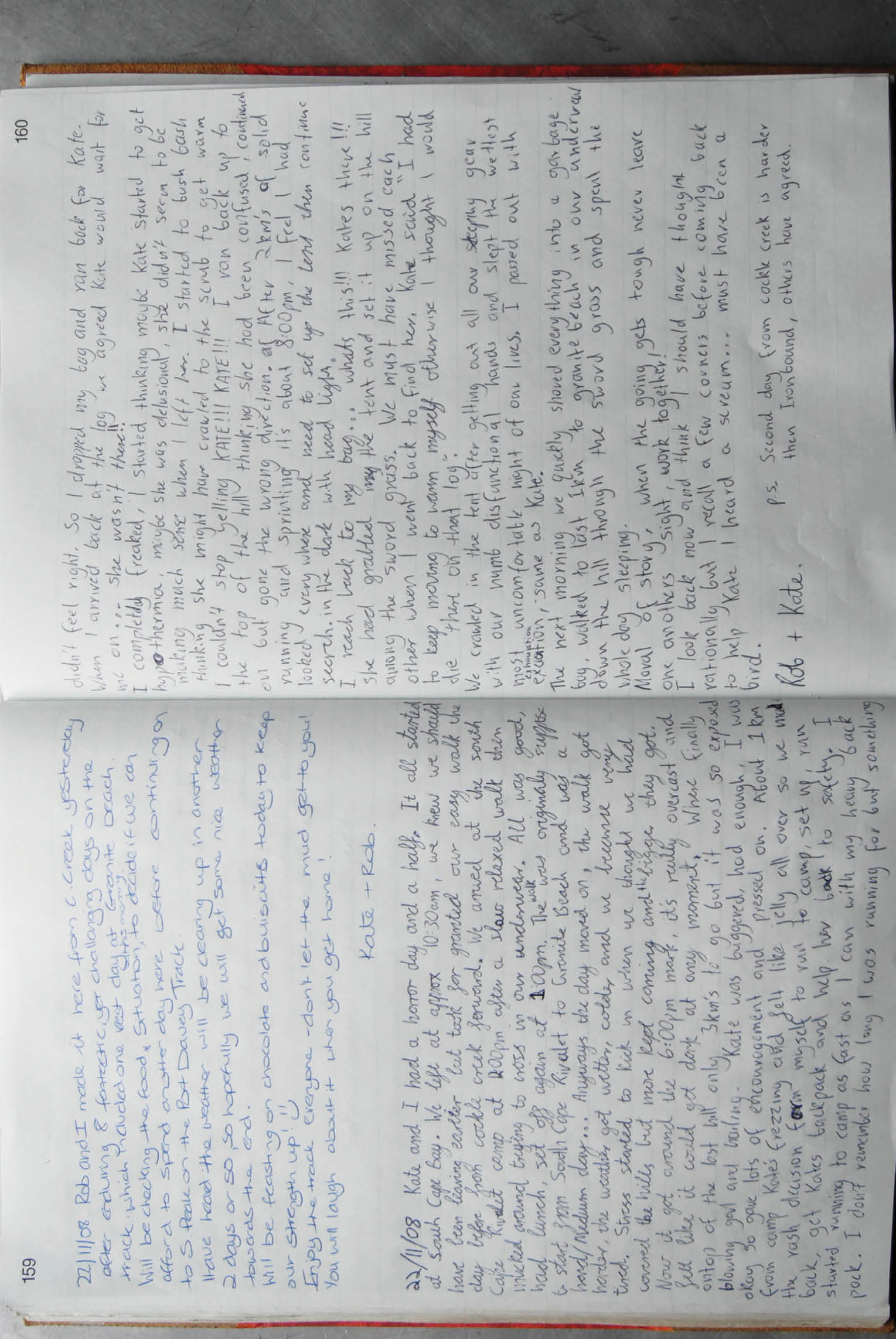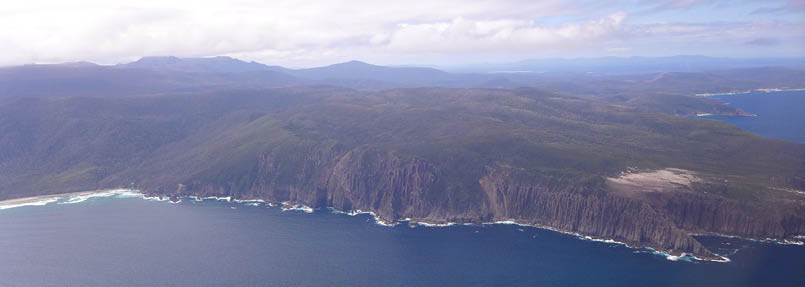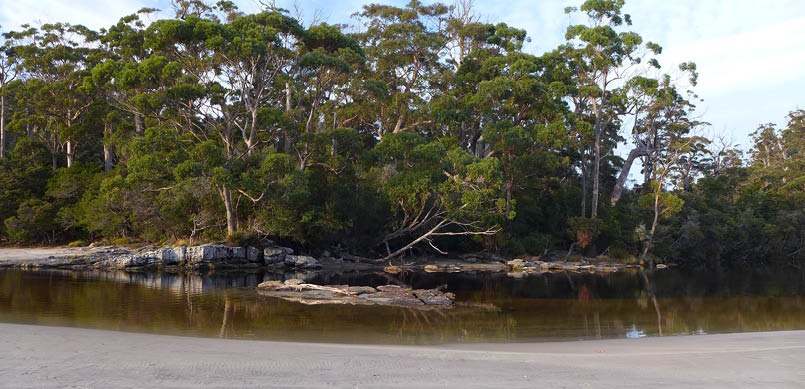



Pages from the Melaleuca log book
A few years ago two walkers nearly came to grief on Tasmania's South Coast Track. The first part is a transcript of a portion of the Melaleuca Inlet log book. The names and dates have been changed. The second part is an analysis of the events through the eyes of Stephen Lake, with significant additions by North-north-west and Mark Fowler in the body of the article.

Melaleuca Log Book

22 | BWA October 2016


Day one, summerTim and I made it here from Cockle Creek yesterday after enduring eight fantastic yet challenging days on the South Coast Track, which included one rest day at Granite Beach. Will be checking the food situation this morning to decide if we can afford to spend another day here before continuing on to Scotts Peak on the Port Davey Track.
Have heard the weather will be clearing up in another two days or so, so hopefully we will get some nice weather towards the end.
Will be feasting on chocolate and biscuits today to keep up our strength. ☺
Enjoy the track everyone – don't let the mud get to you! You will laugh when you get home. Sandra and Tim
Entry on the same daySandra and I had a horror day and half. It all started at South Cape Bay. We left at about 10.30 am, we knew we should have left earlier but took for granted our easy walk the day before from Cockle Creek. We arrived at South Cape Rivulet camp at noon after a slow relaxed walk then mucked around trying to cross in our underwear. All was good, had lunch, set off again at 1.00 pm. The walk was originally supposed to start from South Cape Rivulet to Granite Beach and was a hard-medium day … Anyway, the day moved on, the walk got harder, the weather got wetter and colder, and we became very tired. Stress started to kick in when we thought we had covered the hills, but more kept coming and the bigger they got. Now it got around the 6 pm mark, it's really overcast and felt like it could get dark at any moment. We're finally on top of the last hill only three kilometres to go but it was so exposed, blowing a gale and hailing. Sandra was buggered, had enough. I was okay, so I gave lots of encouragement and pressed on. About a kilometre from camp Sandra's freezing and felt like jelly all over, so we made the rash decision for myself to run to camp, set up, run back, get Sandra's pack, and help her to safety. I started running to camp as fast as I can with my heavy pack. I don't remember how fast I was running for but something didn't feel right. So I dropped my pack and ran back for Sandra. When I arrived at the log where
we agreed Sandra would wait … she wasn't there!!
I was completely freaked. I started thinking maybe Sandra started to get hypothermic, maybe she was delusional, she didn't seem to be making much sense when I left her. I started to bush bash thinking she might have crawled to the scrub to get warm. I couldn't stop yelling, SANDRA!!! SANDRA!!! I ran back up to the top of the hill thinking she had been confused, continued on but gone in the wrong direction. After two kilometres of running and sprinting it's about 8.00 pm, I feel I had looked everywhere and need to set up the tent then continue the search in the dark with a headlight.
I reached into my pack … what's this!!! Sandra's there!!! She had grabbed the tent and set it up on the hill among the sword grass. We must have missed each other when I ran back to find her. Sandra said, “I had to keep moving to warm myself otherwise I thought I would die there on that log.”
We crawled into the tent after getting out all our sleeping gear with our numb dysfunctional hands and slept the wettest most unconformable night of our lives. I passed out with exhaustion, same as Sandra.
The next morning we quickly shoved everything into a garbage bag, walked the last kilometre to Granite Beach in our underwear, down the hill through the sword grass and spent the whole day sleeping.
Moral of the story: when the going gets tough never leave one another's sight, work together.
I look back now and think I should have thought rationally and I recall a few concerns before coming back to help Sandra – I heard a scream … must have been a bird.Tim and Sandra
PS. Second day from Cockle Creek is harder than The Ironbounds, others have agreed.
“About a kilometre from camp Sandra's freezing and felt like jelly all over ...
“I was completely freaked.
BWA October 2016 | 23

What went wrong?
AnalysisIt is a maxim of adverse incidents that it's usual for several things to go wrong prior to and thus causing the incident, or for there to be a cascade, with each item causing another until the incident. The above fits this maxim.
Departure timeThe first point is the departure time – 10.30 am is far too late. On summer trips I'm walking by 6.30-7 am at the latest, giving a lot of time to reach the next camp, which is usually about noon-2 pm, ready for a bludge, missing the heat. Had Tim and Sandra left at 8 am then they would have had more daylight. Tim said “around the 6 pm mark, it's really overcast and felt like it could get dark at any moment.” Leaving at 8 am would have also beaten most of the bad weather.
At South Cape Rivulet they “mucked around trying to cross”. Oops. Just go! In fact arriving at noon and clearing it by 1 pm after lunch is acceptable. However, delays add up.
Trip too hardTim said that after South Cape Rivulet the day got harder. Is the SCT that hard? The weather deteriorated – not much can be done about that. Tim says “we became very tired. Stress started to kick in”. To the late start, long day and bad weather, most probably another aspect that adversely affects matters can be added – lack of fitness and stamina. I've been tired and dispirited on walks, but I've never been stressed. Did Tim and Sandra have unrealistic expectations
about the walk? Did they underestimate the walk or overestimate their capabilities? It appears so.
They may have been absorbed with photography. The mud starts here. Many people really don't understand how draining it can be trying to climb in deep mud, and many tend to waste time trying to bypass it. The wet conditions would also have been making things worse. But it's likely the biggest contributor was lack of appropriate walk fitness.
The South Coast Walks map from Tasmap (Ed 2 1997) which they were likely to be using does not show Trackcutters camp and states “No campsites are found on the range.” The map also gives the time for Granite Beach to South Cape Rivulet as 6-8 hours medium/hard walking.
Camp seems to have been made near the east end of the SCT at South Cape Bay. They left here at 10.30 am and reached South Cape Rivulet at noon, 90 minutes of flat track to walk a bit over two kilometres. This is slow! After clearing South Cape Rivulet at 1 pm, in deteriorating conditions it then took about five hours to reach the top of the South Cape Range, after 6 pm. This is about seven kilometres, just over one kilometre/hour.
Leaving South Cape Rivulet at 1 pm was very late, suggesting an arrival at Granite Beach at 6 to 8 pm by Chapman's times or 7 to 9 pm by the Walks map timing. This leaves absolutely no time for stops or any delays. The fact that they reached the top of the range after about five hours actually shows they were walking at a fairly acceptable pace. The descent to Granite Beach is quite quick
South Cape RangeMark Fowler
“ Did Tim and Sandra have unrealistic expectations about the walk?
24 | BWA October 2016

and relatively mud free once one gets to the end of Flat Rock Plain.
The days were unbalanced. It seems that the days were:
Cockle Creek to South Cape Bay 8 kilometres, flat
South Cape Bay to near Granite Beach 12 kilometres, up 700 metres
If at all possible they should have camped at South Cape Rivulet, making 10 kilometre for each day. This and an 8 am start would have seen them at Granite Beach by about 4 pm at the latest. As the second day is shorter it would have been easier, they would have been fresher at the end, and, as mentioned above, the weather would have been better. Also – importantly I think – there would not be a psychological cloud hanging over them as matters deteriorated. Another point is that the South Cape Rivulet crossing is tidal, so crossing on the first day would avoid having to wait for the tide the next day. John Chapman says 5-7 hours Granite Beach to South Cape Rivulet, so it would be about the same going the other way. Did they read the book? This is just a guess but I suspect they had no idea what SW mud can be like.
Camping earlierIf bad weather and tiredness are approaching, consider camping. I always have a number of options such as water points, campsites and escape routes ready for instant use. Camp should have been considered mid-afternoon on the east side of the South Cape Range, the high point of which is the last hill three kilometres from Granite Beach. After all their struggles they did not reach Granite Beach and camped on the west side of the South Cape Range. An east side campsite is more sheltered and allows camp to be set up while less tired, at about 5 pm. While not ideal, Trackcutters Camp on the east side is indicated.
It sounds like they were fixated on getting to Granite Beach and either didn't consider or didn't know about Trackcutters, and by the time they topped out the range it was too late to go back.
Keep togetherSeparating was ill-advised. I've seen people lose obvious tracks. On another trip on the SCT there was a tree over the track. The party was east-bound, strung out, should not be any problems. Reach the tree, turn right to get around it, reach the end, a U-turn to the left, back to the track, turn right, continue. One person missed the U-turn and walked several kilometres across open trackless terrain until he hit the beach. He was not missed for a while. Oops. This is another common mistake for newbies and the over-confident.
South Cape RivuletMark Fowler
“ It's always advisable to keep together if a person is injured.
“ After all their struggles they did not reach Granite Beach ...
BWA October 2016 | 25
It's always advisable to keep together if a person is injured. It seems that Tim and especially Sandra had hypothermia-exhaustion, with the long day, terrain, temperature and precipitation taking their toll on what very much seems to be unfit people. If Sandra was struggling with her pack I'd do 100 metre shuttles, carrying one pack, then going back for Sandra's pack. Going a kilometre is too far. Tim says “maybe Sandra started to get hypothermic, maybe she was delusional, she didn't seem to be making much sense”. Not making sense is a clear indication of hypothermia-exhaustion. Had Tim so assessed Sandra before he left then he may have stayed close by, but his judgement was most probably clouded as well. All that running would have drained him of energy, made him more likely to succumb.
This is a classic escalation. One of the major problems with hypothermia and fatigue is the way they affect your capacity to think and make rational decisions. This helps explain the tunnel vision “must reach Granite Beach” attitude.
ClothingTim refers to “our numb dysfunctional hands”. It seems that they did not have gloves, or if they did, they were inadequate. I've walked in summer with light gardening gloves to keep off flies, and these gloves were adequate for a day when the temperature dropped to just above zero. I had four layers on top, thermal hat, worked fine. I wonder if they had enough clothing.
Other issuesThere is nothing mentioned about stopping for a snack or drink. Were they well hydrated and eating during the afternoon? A snack and hot drink may have helped them keep going.
Were they used to carrying the weight of their packs? People often carry too much on longer trips, especially clothes and “just in case” items. Extra, unfamiliar pack weight really slows you down in mud.
Lack of experienceDue to all the above, it very much seems that they lacked experience. I also wonder about equipment, especially clothing. It's not just about the gloves - while it can get cold on the SCT the main issue is usually wind-chill
and moisture. It's not exactly alpine, after all. Did they have decent waterproofs? What sort of base layers were they wearing? How much layering? This goes to preparation again: how much did they find out about Tassie, about the South West and about the track before heading off? There are a lot of questions I'd like to be able to ask them.
SummaryA number of poor decisions were made, cascading towards the end. I consider them both to be very lucky not to be dots on a graph. I hope they learned. Nature can be very unforgiving.
To read more on the topic here's a good news story about sticking together. And this is an example of what can go wrong by not sticking together and poor communication.
C'est la vie. Fortunately it didn't end in la mort. (Funny that both life and death are female. We women usually get the rough end of the pineapple in these things.)
I suspect this happens far more frequently than we realise. We usually only hear about the cases when it gets to the SAR stage (except when you get incidents like Edith). I've been in situations not too dissimilar, both diving and walking, and owe my survival in part to simply not having been unlucky enough for it to go sufficiently pear-shaped to kill me.North-north-west
I agree totally with NNW's comments. To me the major issue was separating, particularly given Sandra's potential hypothermia. Many mainland walkers have never encountered anything like Tassie mud and the South Cape Range is a particularly good mud example. I suspect that many walkers do not buy Chapman’s book but rely on websites and the Tasmap for the walk which has basic information and minimal track notes.Mark Fowler
26 | BWA October 2016